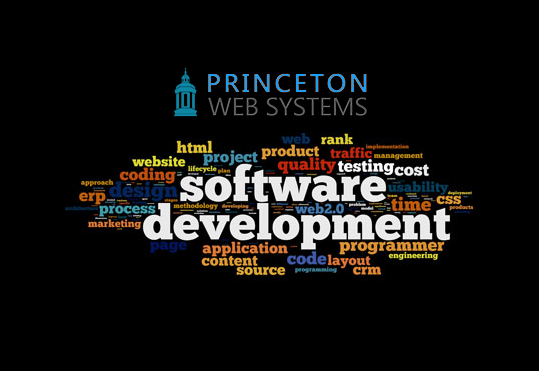Professional Microsoft .Net Development
Princeton Web Systems works closely with Microsoft to develop .NET projects.
Dedicated .Net R&D Team
Princeton Web Systems’ dedicated Microsoft .NET R&D team is responsible for research of the latest software releases, testing new technologies and knowledge sharing with the rest of the team. Members of this group have attended numerous technical seminars organized by Microsoft in France, India and the U.S., and possess years of expertise developing on this platform. The dedicated Microsoft .NET development team enjoys full support by Microsoft through our dynamic partnership program.
Technical Capabilities
Software Design and Development Lifecycle
- Agile Software Development
- Team Development
- Continuous Integration using Microsoft Team Foundation Server (TFS)
- Unit-testing: MSUnit, NUnit
- Model Driven Development
- UML modeling
Enterprise Applications
- Windows Communication Foundation (WCF) & SOA
- Windows Workflow Foundation (WWF)
- Enterprise Services
- Microsoft Enterprise Library
- Windows Services
- Microsoft Cluster Service (MSCS)
- Component Load Balancing (CLB)
- Microsoft Network Load Balancing Services (NLB)
Distributed Applications
- Windows Azure Cloud Applications
- Distributed Transactions
- Web Services
- Web Service Extensions, SOAP customization, XSD usage
- Remoting
- Custom Remoting: marshaling, channeling, security
- BizTalkv
- MSMQ
Web-Based Applications
- ASP.NET
- Third party controls
- Custom controls
- AJAX
- XML/XSLT
- Master Pages
- ASP.NET MVC
- Silverlight
- Microsoft Office SharePoint Server (MOSS)
- Windows SharePoint Services (WSS)
- Microsoft SharePoint Server (SharePoint 2010)
- FAST Search Server 2010 for SharePoint
Desktop Applications
- Windows Presentation Foundation (WPF)
- WinForms
- Third party controls
- Custom controls
- Asynchronous data and message processing
- Custom designers
- Smart Clients
- Composite Application Blocks (CAB)
- Smart Client Software Factory (SCSF)
- Microsoft Surface
- 2D Graphics
- GDI+
- Font management
Mobile Applications
- Windows Phone 7
- Compact Framework
- Web services collaboration
- SQL Server CE
Data Access, Management, Reporting and Analysis
- RDBMS
- Microsoft SQL Server 2000, 2005, 2008, SQL Express
- ORM
- LINQ
- Entity Framework
- NHibernate
- Data Access and Management
- ADO.NET, DataSets
- MSSQL Server Integration Services (SSIS)
- Reporting
- Microsoft SQL Server Reporting Services
- Crystal Reports
- Analisys
- OLTP
- OLAP
- Multi-dimensional Data Processing
Advanced Development Technologies
- Reflection (dynamic emitting of assemblies, CodeDOM, custom attributes, auto generation of Web Service proxy)
- AppDomain management (custom assembly resolving), Garbage collection, GAC
- Security (windows authorization, code access permissions, cryptography usage)
- COM interop/Platform interop
- COM Interop, PInvoke, IE, MS Office and shell integration
- Multithreading (synchronization, thread-safe UI, thread pooling, com interop apartments management)
- Serialization (custom, selective, versioning support)
- Deployment (web deployment, Click Once)
- Globalization (multi-language application support)
Microsoft .NET Framework Versions
- .NET Framework
- 1.x
- 2.0
- 3.x
- 4.0
Migration to Microsoft .NET
In addition to Microsoft .NET skills, Princeton Web Systems' extensive experience with Java, UNIX and various Open Source technologies provide a solid basis for integration and migration projects.
Our methods of migration to Microsoft .NET are based on three pillars:
- Experience. Groups of engineers and analysts with over 1000 hours of experience in the given technology, who research the source product. We have a successful track record of working with popular platforms, poorly documented solutions and with custom client implementations.
- Tools. Migration tools and component libraries (objects, classes, tags, etc.) that facilitate migration.For example, typical components that are employed in migration projects are: DHTML ComboBox with dynamic lookup of values via Web Service, multi-column DropDown for .NET WinForms (similar to Access control), etc. DataArt invested several thousands of hours creating these custom components.
- Customized approach. Migration is always performed by two teams that interact with the customer independently from one another. The first team consists of analysts and QA specialists. It is responsible for coordination and support of information and tools necessary to preserve 100% of useful functionality intact. The second team performs the implementation side of migration using an appropriate technique, for example adaptation, porting, or re-factoring.
Whenever possible and appropriate, we assure that the final product design allows for maximum utilization of the Microsoft .NET advantages:
- Automated deployment from a Web-server, natural both for WebForms and for Windows Forms;
- Availability of re-usable network APIs based on Web Services & remoting for features that are required by third-party applications;
- Possibility of using Windows Forms in MDI and SDI Frameworks and on Web-pages (for integration with Web-portals) without any changes to the code;
- Maximum usage of managed code and universal Microsoft .NET Framework features to simplify future integration with the new generation of Microsoft server platforms.
Working With Cutting-Edge Technologies
Historically, Princeton Web Systems has been investing serious efforts in researching perspective technologies, experimenting with early software releases and maintaining leading-edge development practices. Early research is usually performed by analysts from a dedicated R&D group or through "pilot projects".
In a standard scenario, analysts evaluate the product's or platform's early pre-releases and provide their opinion on the following factors:
- Advantages for potential users
- Advantages in terms of lowering development costs or increased productivity
- Optimization of deployment and operation phases
- Costs involved with training, updating development infrastructure, toolsets, etc.
- Existing vendor's programs supporting the new technology
Provided that the technology looks promising or there is a well-defined client interest, a "pilot project" is organized. The pilot project explores the technology further, with particular attention to:
- Any specifics of development process associated with the new technology
- Risks and constraints, probability of changes in the release version
- Types of applications likely to benefit most from the use of new technology
Many of today's popular technologies have passed through this evaluation process and have been adapted for active use. Microsoft .NET framework itself has been tested through a series of pilot projects, before being selected as a primary development platform at Princeton Web Systems.



